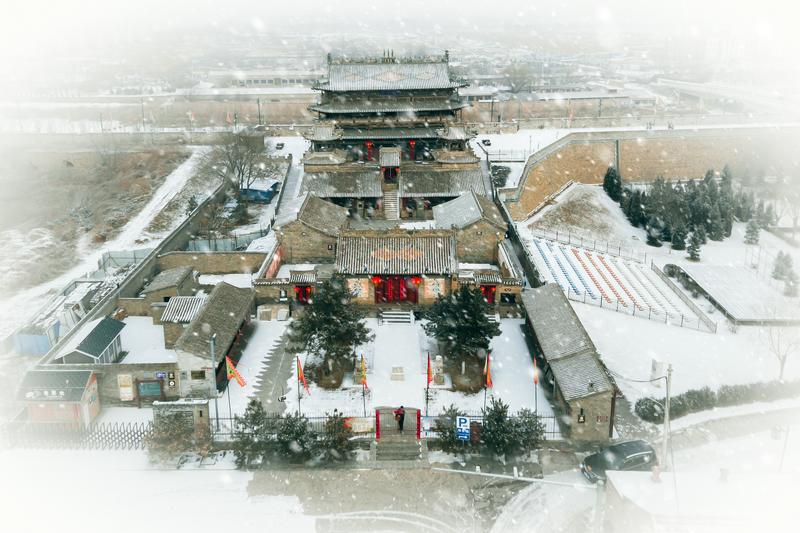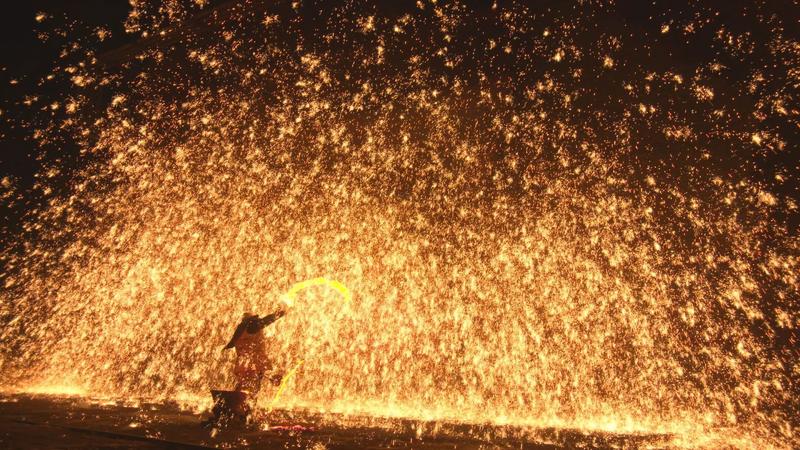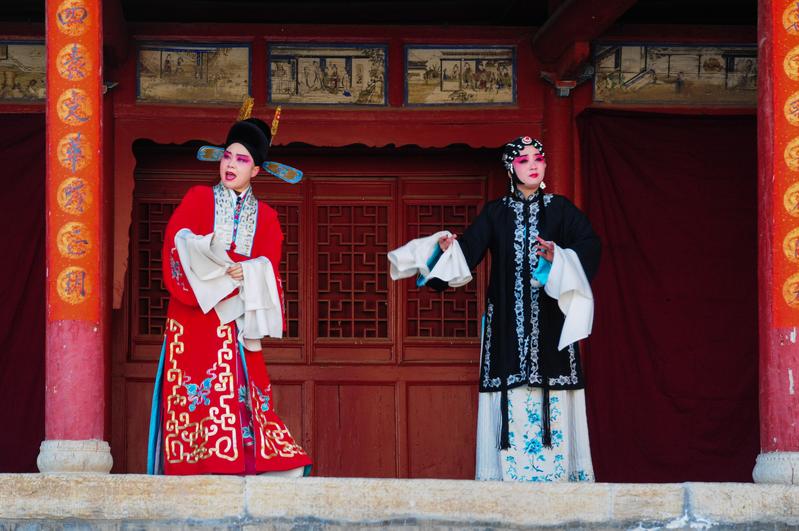Hebei seeks to turn up tourism with traditional crafts, Xu Lin reports.
 An aerial view of Yuhuangge, one of the best-preserved ancient buildings in Yuxian county, Zhangjiakou, Hebei province. (XU LIN / CHINA DAILY)
An aerial view of Yuhuangge, one of the best-preserved ancient buildings in Yuxian county, Zhangjiakou, Hebei province. (XU LIN / CHINA DAILY)
Zhangjiakou city in Hebei province, which co-hosted the Beijing 2022 Winter Olympics, is now turning its focus toward tourism.
About three hours' drive from Beijing, Zhangjiakou's Yuxian county is known for its historical sites, cultural heritage and customs.
As a military fortress, the county, called Yuzhou in ancient times, had built various walled villages along the Great Wall during the Ming Dynasty (1368-1644). Soldiers moved there to guard the region from the northern nomadic people and cultivated the land when there was no war.
Today, the surviving villages-once a masterpiece of traditional military defense-have become popular scenic areas for travelers to learn about the culture of "Chinese castles", surrounded by temples, theaters and old residences.
With traditional eaves and elegant carvings of wood, stone and brick, the imposing buildings and courtyards present the best example of Chinese aesthetics. Locals like to watch shehuo, a folk show, and the local opera, Yuxian yangko, which are performed in these villages.
In 2009, Chinese paper-cutting was inscribed by UNESCO as an Intangible Cultural Heritage of Humanity.
 A performer sprays molten iron into a shower of sparks during a dashuhua performance in Yuxian. (XU LIN / CHINA DAILY)
A performer sprays molten iron into a shower of sparks during a dashuhua performance in Yuxian. (XU LIN / CHINA DAILY)
The craft is popular across the country and has been handed down from generation to generation. It's often used as interior decoration, such as on windows or lintels, during weddings and traditional festivals. In some places, people stick paper patterns on snacks as "auspicious" gifts.
Nanzhangzhuang village is dubbed the "top paper-cutting village in China", with a history of more than 200 years of performing the craft. Paper-cut items are also the perfect tourism souvenir from Yuxian, which employs a unique engraving technique.
Local artisans draw various well-designed patterns, which are bound onto the first page of a stack of thin paper. The patterns include characters from traditional art forms, flowers, birds, fish and insects. They put the paper in water, dry it in the sun, place it on a wax plate and then engrave with a chisel. The process allows them to carve dozens of paper-cut items at one time.
The final step is to paint the finished pieces in different colors using calligraphy brushes.
As this year is the Year of the Tiger, some people from the design team of the opening ceremony of the Winter Games visited Yuxian to seek inspiration from tiger, snow and Spring Festival-themed paper-cuts.
At the opening ceremony on Feb 4, the tiger-head hats worn by the bearers of the placards announcing the teams, and uniforms with patterns of paper-cuts worn by child singers and dancers, caught the eyes of the audience.
"The Games have promoted sales of Yuxian paper-cuts. The items must be created as innovative artistic works, so that the industry can prosper," says local paper-cutting artisan Chen Lin, whose artworks were chosen for the ceremony.
 Performances of a local opera are still popular in the rural area of Yuxian. (XU LIN / CHINA DAILY)
Performances of a local opera are still popular in the rural area of Yuxian. (XU LIN / CHINA DAILY)
Tourists can take a class at his studio to learn how to make their own paper-cuts.
Chen says it takes at least three years for apprentices to master the technique. Only those who can endure hardship will persist.
Many locals, who are migrant workers, can make paper-cuts when the demand is higher, as a part-time job to supplement the family income.
Local craftspeople have also made such items based on the theme of the Winter Olympics. Some of the artworks are on display at Yuzhou Museum, which is a must-visit and showcases cultural artifacts, such as animal fossils, pottery pieces, ceramics, embroidery, paintings and stone statues.
One of the most interesting exhibits is a miniature kitchen range from the Han Dynasty (206 BC-AD 220), with a colorful painting of three women cooking barbecue. Five pieces of meat are hung on a thick rod as one woman chops meat on a board, another holds the pieces on a stove while the third arranges containers for the food.
A funerary object there vividly demonstrates the daily life of the dynasty's aristocratic families.
In Nuanquan town in the county, dashuhua, a traditional show, dates back 500 years. Staged during Lantern Festival, the 15th day of the first lunar month, it has become a regular commercial performance for tourists.
While two performers are in charge of smelting iron and transporting the liquid metal, other blacksmiths who wear sheepskin coats inside out and wet straw hats take turns to use a large wooden ladle, which is soaked in water, to scoop the molten iron onto the city wall, creating a spectacular shower of sparks.
 Yuzhou Museum provides an insight into the county's rich wealth of cultural heritage. (XU LIN / CHINA DAILY)
Yuzhou Museum provides an insight into the county's rich wealth of cultural heritage. (XU LIN / CHINA DAILY)
The audience must keep their distance for safety while watching the show.
"Practice makes perfect. You need to have strength and be bold but stay cautious," says Wang De, 59, who has performed dashuhua in the town for 35 years. "It takes about three years to master the basic technique. The molten iron has a temperature of 1,600 C. It's easy to get scalded if you're a novice."
He used to be a blacksmith and studied dashuhua because of the "exciting experience" it offered. Now it has become a steady job, through which he can support his family.
Yuxian county is a getaway that enables visitors to immerse themselves in traditional culture, temporarily leaving behind the hustle and bustle of city life.
If you go
The Beijing-Zhangjiakou high-speed railway service started in 2019, reducing the travel time between the two cities from about three hours to 53 minutes. Local COVID-19 control policy should be checked before traveling.
Contact the writer at xulin@chinadaily.com.cn


